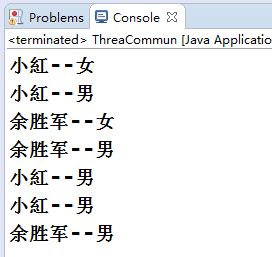3.多线程之间实现通讯
多线程之间实现通讯
一、课程目标
多线程之间如何通讯
wait、notify、notifyAll()方法
lock
停止线程
守护线程
Join 方法
优先级
Yield
二、多线程之间如何实现通讯
2.1 什么是多线程之间通讯?
多线程之间通讯,其实就是多个线程在操作同一个资源,但是操作的动作不同。
画图演示
2. 2 多线程之间通讯需求
需求:第一个线程写入(input)用户,另一个线程取读取(out)用户.实现读一个,写一个操作。

2.3代码实现基本实现
2 .3.1 共享资源源实体类
class Res {
public String userSex;
public String userName;
}
2.3.2 输入线程资源
class IntThrad extends Thread {
private Res res;
public IntThrad(Res res) {
this.res = res;
}
public void run() {
int count = 0;
while (true) {
if (count == 0) {
res.userName = "余胜军";
res.userSex = "男";
} else {
res.userName = "小紅";
res.userSex = "女";
}
count = (count + 1) % 2;
}
}
}
2.3.3 输出线程
class OutThread extends Thread {
private Res res;
public OutThread(Res res) {
this.res = res;
}
public void run() {
while (true) {
System.out.println(res.userName + "--" + res.userSex);
}
}
2.3.4 运行代码
Res res = new Res();
IntThrad intThrad = new IntThrad(res);
OutThread outThread = new
OutThread(res);
intThrad.start();
outThread.start();
2.3.5 运行代码

注意:数据发生错乱,造成线程安全问题
2.3.6 解决线程安全问题
2.3.6.1 IntThrad 加上synchronized
class IntThrad extends Thread {
private Res res;
public IntThrad(Res res) {
this.res = res;
}
public void run() {
int count = 0;
while (true) {
synchronized(res) {
if (count == 0) {
res.userName = "余胜军";
res.userSex = "男";
} else {
res.userName = "小紅";
res.userSex = "女";
}
count = (count + 1) % 2;
}
}
}
}
2.3.6.2 输出线程加上synchronized
class OutThread extends Thread {
private Res res;
public OutThread(Res res) {
this.res = res;
}
public void run() {
while (true) {
synchronized(res) {
System.out.println(res.userName + "--" + res.userSex);
}
}
}
}
2.4 wait() 、 notify 、 notifyAll() 方法
wait()、notify()、notifyAll()是三个定义在 Object 类里的方法,可以用来控制线程的状态。
这三个方法最终调用的都是 jvm 级的 native 方法。随着 jvm 运行平台的不同可能有些许差
异。
• 如果对象调用了 wait 方法就会使持有该对象的线程把该对象的控制权交出去,然后
处于等待状态。
• 如果对象调用了 notify 方法就会通知某个正在等待这个对象的控制权的线程可以继
续运行。
• 如果对象调用了 notifyAll 方法就会通知所有等待这个对象控制权的线程继续运行。
class Res {
public String userSex;
public String userName;
//线程通讯标识
public boolean flag = false;
}
class IntThrad extends Thread {
private Res res;
public IntThrad(Res res) {
this.res = res;
}
public void run() {
int count = 0;
while (true) {
synchronized(res) {
if (res.flag) {
try {
// 当前线程变为等待,但是可以释
放锁
res.wait();
} catch (Exception e) {}
}
if (count == 0) {
res.userName = "余胜军";
res.userSex = "男";
} else {
res.userName = "小紅";
res.userSex = "女";
}
count = (count + 1) % 2;
res.flag = true;
// 唤醒当前线程
res.notify();
}
}
}
}
class OutThread extends Thread {
private Res res;
public OutThread(Res res) {
this.res = res;
}
public void run() {
while (true) {
synchronized(res) {
if (!res.flag) {
try {
res.wait();
} catch (Exception e) {
// TODO: handle exception
}
}
System.out.println(res.userName +
"--" + res.userSex);
res.flag = false;
res.notify();
}
}
}
}
public class ThreaCommun {
public static void main(String[] args) {
Res res = new Res();
IntThrad intThrad = new IntThrad(res);
OutThread outThread = new
OutThread(res);
intThrad.start();
outThread.start();
}
}
2.5 wait 与 wait 区别?
对于 sleep()方法,我们首先要知道该方法是属于 Thread 类中的。而 wait()方法,则是属于
Object 类中的。
sleep()方法导致了程序暂停执行指定的时间,让出 cpu 该其他线程,但是他的监控状态依
然保持者,当指定的时间到了又会自动恢复运行状态。
在调用 sleep()方法的过程中,线程不会释放对象锁。
而当调用 wait()方法的时候,线程会放弃对象锁,进入等待此对象的等待锁定池,只有针对
此对象调用 notify()方法后本线程才进入对象锁定池准备
获取对象锁进入运行状态。
三、 JDK1.5-Lock
在 在 jdk1.5 之后,并发包中新增了 Lock 接口( 以及相关实现类), 用来实现锁功能,Lock 接 接
口提供了与 口提供了与 synchronized 关键字类似的同步功能,但需要在使用时手动获取锁和释放 关键字类似的同步功能,但需要在使用时手动获取锁和释放
锁。
3.1 、Lock写法:
Lock lock = new ReentrantLock();
lock.lock();
try {
// 可能会出现线程安全的操作
} finally {
// 一定在 finally 中释放锁
// 也不能把获取锁在 try 中进行,因为有可能在获取锁的时候抛出异常
lock.ublock();
}
3.2、Lock 接口与 synchronized 关键字的区别
Lock 接口可以尝试非阻塞地获取锁 当前线程尝试获取锁。如果这一时刻锁没有被其他线 当前线程尝试获取锁。如果这一时刻锁没有被其他线
程获取到,则成功获取并持有锁。 程获取到,则成功获取并持有锁。
*Lock 接口能被中断地获取锁 与 synchronized 不同,获取到锁的线程能够响应中断, 不同,获取到锁的线程能够响应中断,
当获取到的锁的线程被中断时,中断异常将会被抛出,同时锁会被释放。 当获取到的锁的线程被中断时,中断异常将会被抛出,同时锁会被释放。
Lock 接口在指定的截止时间之前获取锁,如果截止时间到了依旧无法获取锁,则返回
3.3 Condition用法
Condition 的功能类似于在传统的线程技术中的,Object.wait()和 和 Object.notify()的功 的功
能 能,
代码 代码
Condition condition = lock.newCondition();
res. condition .await(); 类似 wait
res . Condition. Signal() 类似 notify
四、 如何停止线程?
4.1 停止线程思路
1. 使用退出标志,使线程正常退出,也就是当 run 方法完成后线程终止。
2. 使用 stop 方法强行终止线程(这个方法不推荐使用,因为 stop 和 suspend、resume
一样,也可能发生不可预料的结果)。
3. 使用 interrupt 方法中断线程。
class StopThread implements Runnable {
private boolean flag = true;
public synchronized void run() {
while (flag) {
try {
wait();
} catch (Exception e) {
//e.printStackTrace();
stopThread();
}
System.out.println("thread run..");
}
}
public void stopThread() {
flag = false;
}
}
public class StopThreadDemo {
public static void main(String[] args) {
StopThread stopThread1 = new
StopThread();
Thread thread1 = new
Thread(stopThread1);
Thread thread2 = new
Thread(stopThread1);
thread1.start();
thread2.start();
int i = 0;
while (true) {
System.out.println("thread main..");
if (i == 300) {
// stopThread1.stopThread();
thread1.interrupt();
thread2.interrupt();
break;
}
i++;
}
}
}
五、 守护线程
Java 中有两种线程,一种是用户线程,另一种是守护线程。
当进程不存在或主线程停止,守护线程也会被停止。
使用 setDaemon(true)方法设置为守护线程
public class DaemonThread {
public static void main(String[] args) {
Thread thread = new Thread(new Runnable() {
public void run() {
while (true) {
try {
Thread.sleep(100);
} catch (Exception e) {
// TODO: handle exception
}
System.out.println("我是子线程... ");
}
}
}); thread.setDaemon(true); thread.start();
for (int i = 0; i < 10; i++) {
try {
Thread.sleep(100);
} catch (Exception e) {}
System.out.println("我是主线程");
}
System.out.println("主线程执行完毕!");
}
}
六、 join() 方法作用
join 作用是让其他线程变为等待
6.1 需求: 创建一个线程,子线程执行完毕后,主线程才能执行。
class JoinThread implements Runnable {
public void run() {
for (int i = 0; i < 100; i++) {
System.out.println(Thread.currentThread().getName() + "---i:" +i);
}
}
}
public class JoinThreadDemo {
public static void main(String[] args) {
JoinThread joinThread = new
JoinThread();
Thread t1 = new Thread(joinThread);
Thread t2 = new Thread(joinThread);
t1.start();
t2.start();
try {
//其他线程变为等待状态,等t1线程执行完成之后才能执行join方法。
t1.join();
} catch (Exception e) {}
for (int i = 0; i < 100; i++) {
System.out.println("main ---i:" + i);
}
}
}
七、 优先级
现代操作系统基本采用时分的形式调度运行的线程,线程分配得到的时间片的多少
决定了线程使用处理器资源的多少,也对应了线程优先级这个概念。在 JAVA 线程
中,通过一个 int priority 来控制优先级,范围为 1-10,其中 10 最高,默认值为 5。
下面是源码(基于 1.8)中关于 priority 的一些量和方法。
class PrioritytThread implements Runnable {
public void run() {
for (int i = 0; i < 100; i++) {
System.out.println(Thread.currentThread().toString() + "---i:" +i);
}
}
}
public class ThreadDemo4 {
public static void main(String[] args) {
PrioritytThread prioritytThread = new
PrioritytThread();
Thread t1 = new
Thread(prioritytThread);
Thread t2 = new
Thread(prioritytThread);
t1.start();
// 注意设置了优先级, 不代表每次都一定会被执行。 只是CPU调度会有限分配
t1.setPriority(10);
t2.start();
}
}
八、 Yield 方法
Thread.yield()方法的作用:暂停当前正在执行的线程,并执行其他线程。(可能没有效
果)
yield()让当前正在运行的线程回到可运行状态,以允许具有相同优先级的其他线程获得运
行的机会。因此,使用 yield()的目的是让具有相同优先级的线程之间能够适当的轮换执行。
但是,实际中无法保证 yield()达到让步的目的,因为,让步的线程可能被线程调度程序再
次选中。
结论:大多数情况下,yield()将导致线程从运行状态转到可运行状态,但有可能没有效果。
九、 练习题
9.1 有 T1、T2、T3 三个线程,如何怎样保证 T2 在 T1 执行完后执行,T3 在 T2 执行完后执行?
分类:
Java / Interview



【推荐】国内首个AI IDE,深度理解中文开发场景,立即下载体验Trae
【推荐】编程新体验,更懂你的AI,立即体验豆包MarsCode编程助手
【推荐】抖音旗下AI助手豆包,你的智能百科全书,全免费不限次数
【推荐】轻量又高性能的 SSH 工具 IShell:AI 加持,快人一步
· DeepSeek 开源周回顾「GitHub 热点速览」
· 物流快递公司核心技术能力-地址解析分单基础技术分享
· .NET 10首个预览版发布:重大改进与新特性概览!
· AI与.NET技术实操系列(二):开始使用ML.NET
· .NET10 - 预览版1新功能体验(一)